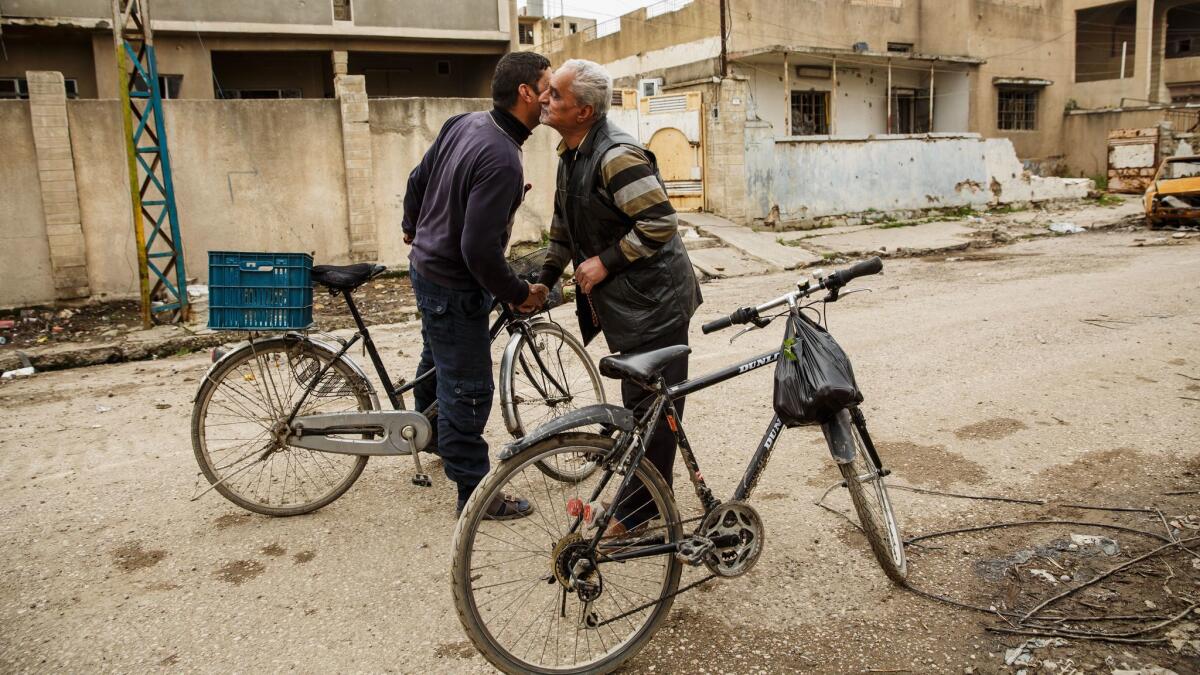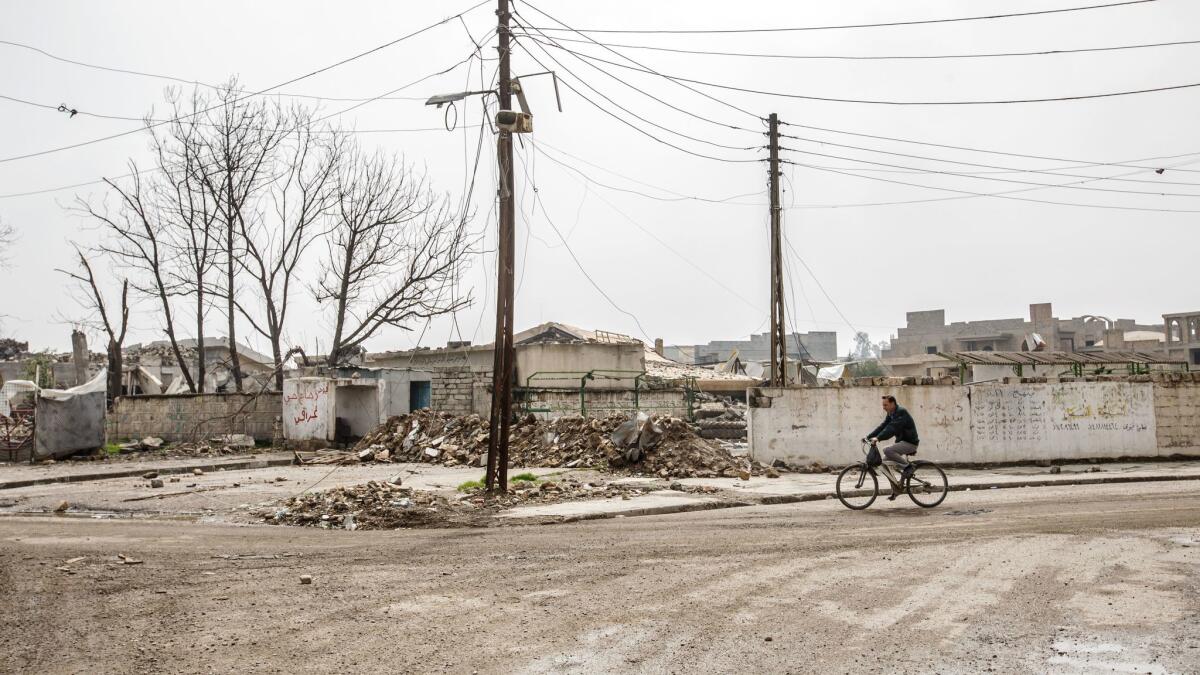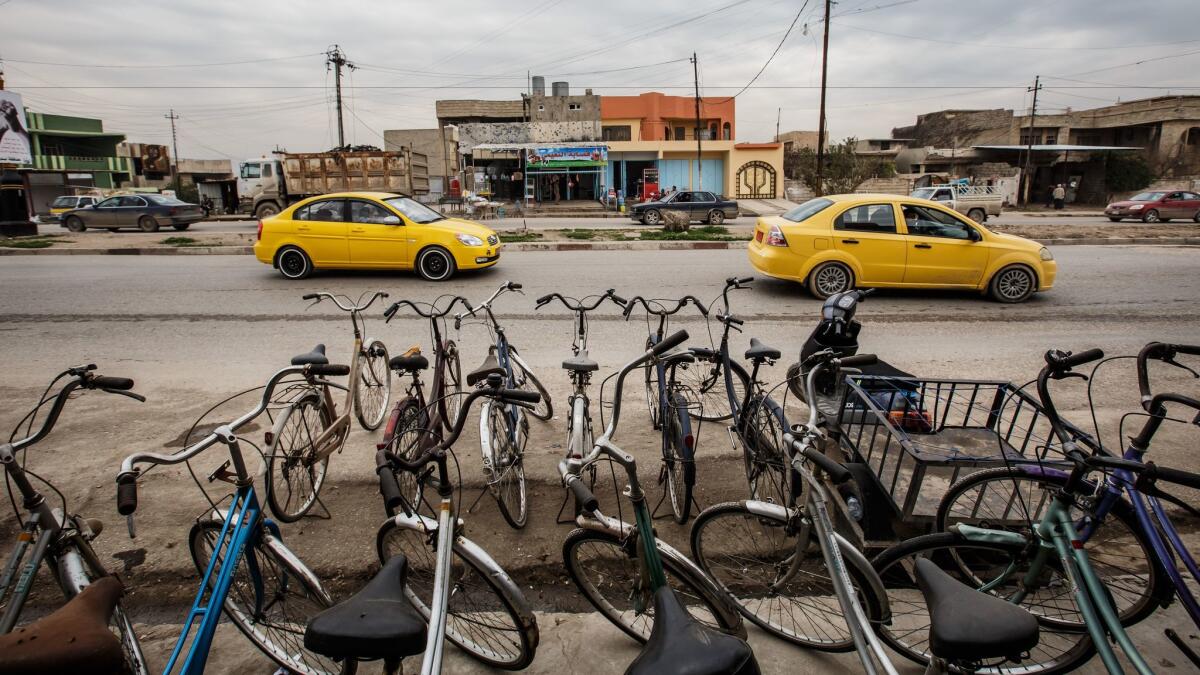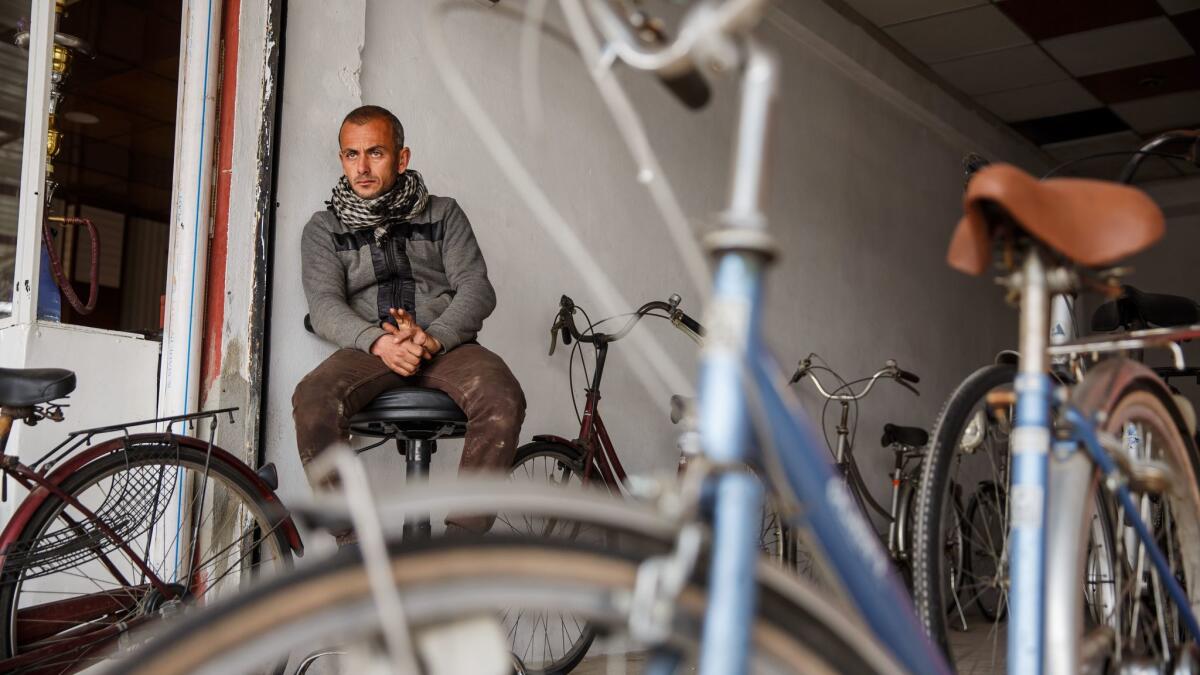Dodging rubble is one thing — in Mosul, cyclists contend with mortars and gunfire too

- Share via
Reporting from Mosul, Iraq — Biking through the rubble-choked streets of this besieged city’s west side, Mohammed Kamal Mahmoud paused to explain his family’s criteria for venturing out aboard its battered, mud-caked, three-speed cycle.
“When the airstrikes are heavy, we are not driving it around,” the mechanic said. As he spoke, Iraqi military helicopters fired overhead, and a few streets away gunfire, mortars and rockets boomed.
Many of Mosul’s 1.2 million residents have been trapped between militants and Iraqi forces since the offensive to recapture the city from Islamic State began in October. While traffic has returned to the city’s east side, where the militants have been driven out, Iraqi forces still battling on the west side have barred cars — which Islamic State uses as suicide vehicles — and motorcycles.
This has turned Mosul into a city of bikes.

Mahmoud’s bicycle basket contained a dwindling supply of medication for his mother, who has diabetes and high blood pressure. The local pharmacy has been shuttered since the offensive started, and he was trying to figure out where to refill her prescriptions.
“It’s become very expensive,” he said.
He has not had any close calls while biking, other than flat tires from the rubble (he carries a bike pump in his baskets for those, but like every other Mosul bicyclist and most Iraqi soldiers, he never wears a helmet).
A friend bicycling by Mahmoud stopped, flicked his kickstand and greeted him with the customary kiss on the cheek. He suggested the mechanic leave their Tayran neighborhood and try a pharmacy in the nearby city center.
Mahmoud shook his head.
“No, it’s not free yet,” he said, before pedaling away past the hulk of a burned yellow taxi embedded in a dirt berm.
Residents said Islamic State militants burned many of their cars as they withdrew from the area, turning some into obstacles to halt advancing Iraqi troops.
Qusay Tawfiq has lived on the west side for 50 years, and said he can’t understand why residents are not allowed to drive. He has been unable to see a doctor, to claim his salary from Iraq’s agricultural ministry or to move any of his three cars to safety on the east side.
“The area has been freed. People should be able to leave,” he said, tearing up. “We suffered a lot under ISIS.”
There was once a flourishing bicycle trade in west Mosul, with shops lined up along the banks of the Tigris River, which bisects the city. But the stores were shuttered after the offensive began, residents said, and are unlikely to reopen anytime soon.
Private sellers on the west side were hawking bikes for $100 to $200, residents said, an exorbitant sum for families unable to leave the area for months to work or claim government salaries.

“Before, it was cheap — $20,” said Saleh Hussein, who stopped while riding his red Dunlop past a federal police checkpoint.
Many on the west side, like Hussein, already had old bicycles, which they dusted off and equipped with multiple baskets to haul supplies.
“I used to have a motorcycle,” he said wistfully. He stopped using it even before they were banned because of gas shortages.
Mohammed Sabah Yehia once ran a motorcycle shop on the west side, but it was destroyed during the offensive. He recently opened a bicycle shop on the east side, in a block full of reopened storefronts. The first week, he sold 10 cruisers for $65 to $70.

All are women’s bikes. Women don’t ride them — it wasn’t customary even before Islamic State captured the city in 2014. Mosul men simply consider women’s models easier to handle, Yehia said.
Around the corner, the main highway into east Mosul was so packed with yellow taxis, family minivans and pickup trucks that a traffic jam developed. One bicyclist said he owned a car but was biking to avoid traffic.
Obeida Ismail, 19, parked a black scooter outside Yehia’s shop briefly. He has a bicycle, but borrowed the scooter from a friend so he could get to his job at a nearby butcher’s more quickly. It was a risky ride: While cars have returned to the east side, motorcycles have been slower to reappear because Ismail and others are still worried about being stopped by police.
“If the police see me, they might take it away,” he said.
Standing nearby, his friend Muthana Mirwan nodded.
“Because Daesh is using motorcycles,” said Mirwan, 24, using the Arabic acronym for Islamic State.
Although Islamic State has been defeated on the east side of Mosul, residents still avoid biking at night out of fear of remaining militant “sleeper cells,” he said. Yehia, the bike store owner, said he feels safe anyway, but even he refuses to ride in west Mosul.
“It’s war there! Why would I go?” he said, laughing. “When it’s secure, I might go there to sell bicycles.”

Iraqi forces still battling on the west side have barred cars — which Islamic State uses as suicide vehicles — and motorcycles. This has turned Mosul into a city of bikes.
Twitter: @mollyhf
ALSO
‘Take Ahmed and let me die’: Victims of U.S. airstrike in Mosul recount a day of horror
These Syrians were finally being evacuated to safety. That’s when the bomb went off
With nowhere to turn, refugees crowd makeshift camps as they flee the Islamic State in Iraq
More to Read
Sign up for Essential California
The most important California stories and recommendations in your inbox every morning.
You may occasionally receive promotional content from the Los Angeles Times.











